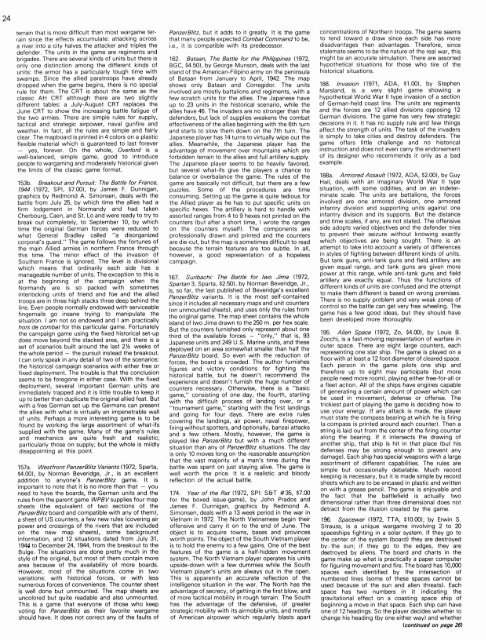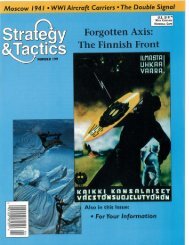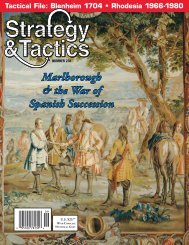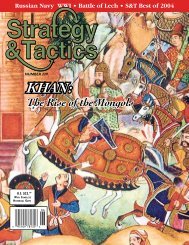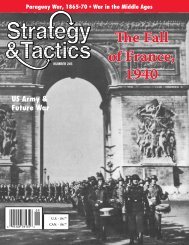the franco-prussian war - Strategy & Tactics
the franco-prussian war - Strategy & Tactics
the franco-prussian war - Strategy & Tactics
You also want an ePaper? Increase the reach of your titles
YUMPU automatically turns print PDFs into web optimized ePapers that Google loves.
terrain that is more difficult than most <strong>war</strong>game terrainsince <strong>the</strong> effects accumulate: attacking acrossa river into a city halves <strong>the</strong> attacker and triples <strong>the</strong>defender. The units in <strong>the</strong> game are regiments andbrigades. There are several kinds of units but <strong>the</strong>re isonly one distinction among <strong>the</strong> different kinds ofunits: <strong>the</strong> armor has a particularly tough time withswamps. Since <strong>the</strong> allied paratroops have alreadydropped when <strong>the</strong> game begins, <strong>the</strong>re is no specialrule for <strong>the</strong>m. The CRT is about <strong>the</strong> same as <strong>the</strong>classic AH CRT although <strong>the</strong>re are two slightlydifferent tables: a July-August CRT replaces <strong>the</strong>June CRT to show <strong>the</strong> increasing battle fatigue of<strong>the</strong> two armies. There are simple rules for supply,tactical and strategic airpower, naval gunfire andwea<strong>the</strong>r. In fact, all <strong>the</strong> rules are simple and fairlyclear. The mapboard is printed in 4 colors on a plasticflexible material which is guaranteed to last forever- yes, forever. On <strong>the</strong> whole, Overlord is awell-balanced, simple game, good to introducepeople to <strong>war</strong>gaming and moderately historical given<strong>the</strong> limits of <strong>the</strong> classic game format.153b. Breakout and Pursuit: The Battle for France,1944 (1972, SPI, $7.03, by James F. Dunnigan,graphics by Redmond A. Simonsen, deals with <strong>the</strong>battle from July 25, by which time <strong>the</strong> allies had afirm lodgement in Normandy and had takenCherbourg, Caen, and St. Lo and were ready to try tobreak out completely, to September 10, by whichtime <strong>the</strong> original German forces were reduced towhat General Bradley called "a disorganizedcorporal's guard." The game follows <strong>the</strong> fortunes of<strong>the</strong> main Allied armies in nor<strong>the</strong>rn France throughthis time. The minor effect of <strong>the</strong> invasion ofSou<strong>the</strong>rn France is ignored. The level is divisionalwhich means that ordinarily each side has amanageable number of units. Theexception to this isat <strong>the</strong> beginning of <strong>the</strong> campaign when <strong>the</strong>Normandy are is so packed with sometimesinterlocking units of friend and foe and <strong>the</strong> alliedtroops are in three high stacks three deep behind <strong>the</strong>line. Even people normally endowed with serviceablefingernails go insane trying to manipulate <strong>the</strong>situation. I am not so endowed and I am practicallyhors de combat for this particular game. Fortunately<strong>the</strong> campaign game using <strong>the</strong> fixed historical set-updoes move beyond <strong>the</strong> stacked area, and <strong>the</strong>re is aset of scenarios built around <strong>the</strong> last 2% weeks of<strong>the</strong> whole period - <strong>the</strong> pursuit instead <strong>the</strong> breakout.I can only speak in any detail of two of <strong>the</strong> scenarios:<strong>the</strong> historical campaign scenarios with ei<strong>the</strong>r free orfixed deployment. The trouble is that <strong>the</strong> conclusionseems to be foregone in ei<strong>the</strong>r case. With <strong>the</strong> fixeddeployment, several important German units areimmediately trapped and it is little trouble to keep itup to better than duplicate <strong>the</strong> original allied feat. Butwith a free German set up <strong>the</strong> Germans can present<strong>the</strong> allies with what is virtually an impenetrable wallof units. Perhaps a more interesting game is to befound by working <strong>the</strong> large assortment of what-ifssupplied with <strong>the</strong> game. Many of <strong>the</strong> game's rulesand mechanics are quite fresh and realistic;particularly those on supply; but <strong>the</strong> whole is mildlydisappointing at this point.157a. Westfronr PanzerBlitz Variants (1972, Sparta,$4.001, by Norman Beveridge, Jr., is an excellentaddition to anyone's PanzerBlitz game. It isimportant to note that it is no more than that - youneed to have <strong>the</strong> boards, <strong>the</strong> German units and <strong>the</strong>rules from <strong>the</strong> parent game WPBV supplies four mapsheets (<strong>the</strong> equivalent of two sections of <strong>the</strong>PanzerBlitz board and compatible with any of <strong>the</strong>m),a sheet of US counters, a few new rules (covering airpower and crossings of <strong>the</strong> rivers that are includedon <strong>the</strong> new map sheets), some backgroundinformation, and 12 situations dated from July 31,1944 to December 24, 1944, from <strong>the</strong> breakout to <strong>the</strong>Bulge. The situations are done pretty much in <strong>the</strong>style of <strong>the</strong> original, but most of <strong>the</strong>m contain morearea because of <strong>the</strong> availability of more boards.However, most of <strong>the</strong> situations come in twovariations: with historical forces, or with lessnumerous forces of convenience. The counter sheetis well done but unmounted. The map sheets areuncolored but quite readable and also unmounted.This is a game that everyone of those who keepvoting for PanzerBlirz as <strong>the</strong>ir favorite <strong>war</strong>gameshould have. It does not correct any of <strong>the</strong> faults ofPanzerBlitz, but it adds to it greatly. It is <strong>the</strong> gamethat many people expected Combar Command to be,i.e., it is compatible with its predecessor.162. Bataan, The Battle for <strong>the</strong> Philippines (1972,BGC, $4.50), by George Munson, deals with <strong>the</strong> laststand of <strong>the</strong> American-Filipino army on <strong>the</strong> peninsulaof Bataan from January to April, 1942. The mapshows only Bataan and Corregidor. The unitsinvolved are mostly battalions and regiments, with afew scratch units for <strong>the</strong> allies. The Japanese haveup to 23 units in <strong>the</strong> historical scenario, while <strong>the</strong>allies have 46. The invaders are no stronger than <strong>the</strong>defenders, but lack of supplies weakens <strong>the</strong> combateffectiveness of <strong>the</strong> allies beginning with <strong>the</strong> 6th turnand starts to slow <strong>the</strong>m down on <strong>the</strong> 7th turn. TheJapanese player has 14 turns to virtually wipe out <strong>the</strong>allies. Meanwhile, <strong>the</strong> Japanese player has <strong>the</strong>advantage of movement over mountains which areforbidden terrain to <strong>the</strong> allies and full artillery supply.The Japanese player seems to be heavily favored,but several what-ifs give <strong>the</strong> players a chance tobalance or overbalance <strong>the</strong> game. The rules of <strong>the</strong>game are basically not difficult, but <strong>the</strong>re are a fewpuzzles. Some of <strong>the</strong> procedures are timeconsuming. Setting up <strong>the</strong> game is quite tedious for<strong>the</strong> Allied player as he has to put specific units onspecific hexes. The artillery is hard to handle withassorted ranges from 4 to 9 hexes not printed on <strong>the</strong>counters (but after a short time, I wrote <strong>the</strong> rangeson <strong>the</strong> counters myself). The components areprofessionally drawn and printed and <strong>the</strong> countersare die-cut, but <strong>the</strong> map is sometimes difficult to readbecause <strong>the</strong> terrain features are too subtle. In all,however, a good representation of a hopelesscampaign.167. Suribachi: The Battle for Iwo Jima (1972,Spartan 3, Sparta, $2.50). by Norman Beveridge, Jr.,is. so far, <strong>the</strong> last published of Beveridge's excellentPanzerBlitz variants. It is <strong>the</strong> most self-containedsince it includes all necessary maps and unit counters(on unmounted sheets), and uses only <strong>the</strong> rules from<strong>the</strong> original game. The map sheet contains <strong>the</strong> wholeisland of Iwo Jima drawn to <strong>the</strong> 250 m. per hex scale.But <strong>the</strong> counters furnished only represent about onethird of <strong>the</strong> available forces - "only," that is, 93Japanese units and 249 U.S. Marine units, and <strong>the</strong>sedeployed on an area somewhat smaller than half <strong>the</strong>PanzerBlitz board. So even with <strong>the</strong> reduction offorces, <strong>the</strong> board is crowded. The author furnishesfigures and victory conditions for fighting <strong>the</strong>historical battle, but he doesn't recommend <strong>the</strong>experience and doesn't furnish <strong>the</strong> huge number ofcounters necessary. O<strong>the</strong>rwise, <strong>the</strong>re is a "basicgame," consisting of one day, <strong>the</strong> fourth, startingwith <strong>the</strong> difficult process of landing over, or a"tournament game," starting with <strong>the</strong> first landingsand going for four days. There are extra rulescovering <strong>the</strong> landings, air power, naval firepower,firing without spotters, and optionally, banzai attacksand a few o<strong>the</strong>rs. Mostly, however, <strong>the</strong> game isplayed like PanzerBlirz but with a much differentsituation than any of PanzerBlirz situations. The dayis only 10 moves long on <strong>the</strong> reasonable assumptionthat <strong>the</strong> vast majority of a man's time during <strong>the</strong>battle was spent on just staying alive. The game iswell worth <strong>the</strong> price. It is a realistic and bloodyreflection of <strong>the</strong> actual battle.174. Year of <strong>the</strong> Rat (1972, SPI: S&T #35, $7.00for <strong>the</strong> boxed issue-game), by John Prados andJames F. Dunnigan, graphics by Redmond A.Simonsen, deals with a 13 week period in <strong>the</strong> <strong>war</strong> inVietnam in 1972. The North Vietnamese begin <strong>the</strong>iroffensive and carry it on to <strong>the</strong> end of June. Theobject is to acquire towns, bases and provincesworth points. The object of <strong>the</strong> South Vietnam playeris to hold <strong>the</strong> enemy to a few gains. One of <strong>the</strong> bestfeatures of <strong>the</strong> game is a half-hidden movementsystem. The North Vietnam player operates his unitsupside-down with a few dummies while <strong>the</strong> SouthVietnam player's units are always out in <strong>the</strong> open.This is apparently an accurate reflection of <strong>the</strong>intelligence situation in <strong>the</strong> <strong>war</strong>. The North has <strong>the</strong>advantage of secrecy, of getting in <strong>the</strong> first blow, andof more tactical mobility in rough terrain. The Southhas <strong>the</strong> advantage of <strong>the</strong> defensive, of greaterstrategic mobility with its airmobile units, and mostlyof American airpower which regularly blasts apartconcentrations of Nor<strong>the</strong>rn troops. The game seemsto tend to<strong>war</strong>d a draw since each side has moredisadvantages than advantages. Therefore, sincestalemate seems to be <strong>the</strong> nature of <strong>the</strong> real <strong>war</strong>, thismight be an accurate simulation. There are assortedhypo<strong>the</strong>tical situations for those who tire of <strong>the</strong>historical situations.188. Invasion (1971, ADA, $1.00). by StephenMarsland, is a very slight game showing ahypo<strong>the</strong>tical World War II type invasion of a sectionof German-held coast line. The units are regimentsand <strong>the</strong> forces are 12 allied divisions opposing 12German divisions. The game has very few strategicdecisions in it. It has no supply rule and few thingsaffect <strong>the</strong> strength of units. The task of <strong>the</strong> invadersis simply to take cities and destroy defenders. Thegame offers little challenge and no historicalinstruction and does not even carry <strong>the</strong> endorsementof its designer who recommends it only as a badexample.188a. Armored Assault (1972, ADA, $2.00). by GuyHail, deals with an imaginary World War II typesituation, with some oddities, and on an indeterminatescale. The units are battalions, <strong>the</strong> forcesinvolved are one armored division, one armoredinfantry division and supporting units against oneinfantry division and its supports. But <strong>the</strong> distanceand time scales, if any, are not stated. The offensiveside adopts varied objectives and <strong>the</strong> defender triesto prevent <strong>the</strong>ir seizure without knowing exactlywhich objectives are being sought. There is anattempt to take into account a variety of differencesin styles of fighting between different kinds of units.But tank guns, anti-tank guns and field artillery aregiven equal range, and tank guns are given morepower at this range, while anti-tank guns and fieldartillery are exactly equal. Thus <strong>the</strong> functions ofdifferent kindsof units are confused and <strong>the</strong> attemptto make <strong>the</strong>m different is based on wrong premises.There is no supply problem and very weak zones ofcontrol so <strong>the</strong> battle can get very free wheeling. Thegame has a few good ideas, but <strong>the</strong>y should havebeen developed more thoroughly.195. Alien Space (1972, Zo, $4.001, by Louis B.Zocchi, is a fast-moving representation of <strong>war</strong>fare inouter space. There are eight large counters, eachrepresenting one star ship. The game is played on afloor with at least a 12 foot diameter of cleared space.Each person in <strong>the</strong> game pilots one ship and<strong>the</strong>refore up to eight may participate (but morepeople need more room), playing ei<strong>the</strong>r free-for-all ora fleet action. All of <strong>the</strong> ships have engines capableof generating a certain amount of power which canbe used in movement, defense or offense. Thetrickiest part of playing <strong>the</strong> game is deciding how touse your energy. If any attack is made, <strong>the</strong> playermust state <strong>the</strong> compass bearing at which he is firing(a compass is printed around each counter). Then astring is laid out from <strong>the</strong> center of <strong>the</strong> firing counteralong <strong>the</strong> bearing. If it intersects <strong>the</strong> drawing ofano<strong>the</strong>r ship, that ship is hit in that place (but hisdefenses may be strong enough to prevent anydamage). Each ship has special weapons with a largeassortment of different capabilities. The rules aresimple but occasionally debatable. Much recordkeeping is necessary, but it is made simple by recordsheets which are to be encased in plastic and writtenon with a grease pencil. The game is enjoyable and<strong>the</strong> fact that <strong>the</strong> battlefield is actually twodimensional ra<strong>the</strong>r than three dimensional does notdetract from <strong>the</strong> illusion created by <strong>the</strong> game.196. Space<strong>war</strong> (1972, TTA, $10.00), by Erwin S.Strauss, is a unique <strong>war</strong>game involving 2 to 20spaceships fighting in a solar system. If <strong>the</strong>y go to<strong>the</strong> center of <strong>the</strong> system (board) <strong>the</strong>y are destroyedby. <strong>the</strong> sun; if <strong>the</strong>y go to <strong>the</strong> edges, <strong>the</strong>y aredestroyed by aliens. The board and charts in <strong>the</strong>game make up what is practically a paper computerfor figuring movement and fire. The board has 10,000spaces each identified by <strong>the</strong> intersection ofnumbered lines (some of <strong>the</strong>se spaces cannot beused because of <strong>the</strong> sun and alien threats). Eachspace has two numbers in it indicating <strong>the</strong>gravitational effect on a coasting space ship ofbeginning a move in that space. Each ship can haveone of 12 headings. So <strong>the</strong> player decides whe<strong>the</strong>r tochange his heading (by one ei<strong>the</strong>r way) and whe<strong>the</strong>r(continued on page 26)


